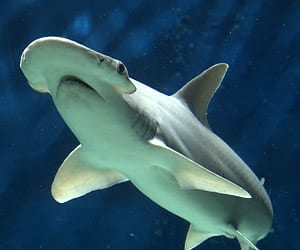
Bonnethead sharks were thought to be solely carnivorous, but according to University of California researchers, they’re omnivorous they can eat both animals and plants.
Bonnetheads, one of the smallest members of the hammerhead family, are abundant in the waters of the Americas, where they usually feed on crab, shrimp, snails and bony fish. Its plant of choice is seagrass. Researchers fed five bonnetheads on a three-week diet of seagrass and squid. All the sharks put on weight over the course of the study. Tests on the sharks showed that they successfully digested the seagrass with enzymes that broke down components of the plants. A possible reason for the sharks’ omnivorous lifestyle is potentially avoiding conflict with other species such as bull sharks or nurse sharks for food.
It is one of the most radical rebrandings in history: contrary to their bloodthirsty image, some sharks are not irrepressible meat eaters, but are happy to munch on vegetation too. According to US researchers, one of the most common sharks in the world, a relative of the hammerhead which patrols the shores of the Americas, is the first variety of shark to be outed as a bona fide omnivore. The bonnethead shark is abundant in the shallow waters of the eastern Pacific, the Western Atlantic, and the Gulf of Mexico, where they feed on crab, shrimp, snails and bony fish. Though small by shark standards, adult females – the larger of the sexes – can still reach an impressive five feet long. Scientists at the University of California in Irvine, and Florida International University in Miami, decided to investigate the sharks’ dietary habits after reading reports of the fish chomping on seagrass, the flowering marine plant that forms subsea meadows in some coastal waters.
To see whether the sharks are truly flexitarian, the scientists retrieved sea grass from Florida Bay and hauled it back to the lab where they re-planted it. As the seagrass took root, the researchers added sodium bicarbonate powder made with a specific carbon isotope to the water. This was taken up by the seagrass, giving it a distinctive chemical signature. The researchers next caught five bonnethead sharks and brought them back to the lab. Once the fish had settled in, they were fed on a three week diet of the seagrass and squid. All of the fish put on weight over the course of the study. The scientists then ran a series of tests on the sharks. These showed that the fish successfully digested the seagrass with enzymes that broke down components of the plants, such as starch and cellulose. Lacking the kind of teeth best suited for mastication, the fish may rely on strong stomach acids to weaken the plants’ cells so the enzymes can have their digestive effects. In all, more than half of the organic material locked up in the seagrass was digested by the sharks, putting them on a par with young green sea turtles.
Credit : The Guardian
Picture Credit : Google




